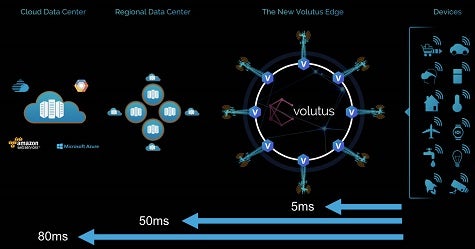After the better part of a decade trying to centralize as much computing as possible by pushing applications into the cloud, the next big thing will be pushing applications out to the edge of the network to be closer to the point where they are consumed.
Vapor IO, a provider of a platform for running applications at the edge of the network, today launched Project Volutus, an initiative that makes it possible to deploy “micro data centers” at the base of cell towers that can be centrally managed via the cloud.
Based on open source Open Data Center Run Time Environment (OpenDCRE) software, Vapor IO CEO Cole Crawford says the Volutus project creates a framework for simplifying the deployment of the Vapor Edge platform using a Vapor Chamber rack enclosure that Vapor IO designed specifically for edge computing environment. As part of Proect Volutus, Vapor IO is also making available FlexRAN and Multi-access Edge Compute (MEC) software libraries developed by Intel to provide a reference design to create a virtual radio access network (vRAN) for integrating micro data centers deployed at the edge of the network.
In addition, Vapor IO has enlisted the aid of Flex to facilitate the deployment of Vapor Chambers, which will be based on a specification for creating interchangeable components defined by the Open 19 Foundation.
Vapor IO has also recruited Packet, a provider of bare-metal cloud services, to be the first cloud service provider to offer a service through which micro data centers can be remotely managed via REST application programming interfaces (APIs).
“Edge computing applications will need to be governed by policies,” says Crawford.
Finally, Crown Castle has pledged to make available 40,000 cell tower locations for deploying Project Volutus software. Crown Castle has also taken a minority ownership stake in Vapor IO.
Crawford says there are a broad range of Internet of Things (IoT) and 5G applications involving technologies such as augmented reality that will need to be deployed at the edge. Because of application latency requirements, deploying those applications in the cloud isn’t feasible, says Crawford. But the cloud, adds Crawford, will play a critical role in managing those distributed applications.
In addition, Crawford notes that machine learning algorithms and other forms of artificial intelligence (AI) software will need to be pushed out to the edge to interact in real time with massive amounts of data being collected.
Running applications at the edge of the network is hardly new. But the level of scale at which it is about to be attempted is unprecedented. As computing platforms have become both denser and physically smaller, the edge of the network continues to become more distributed. The real challenge now is to find a way to manage all those distributed computing platforms.



